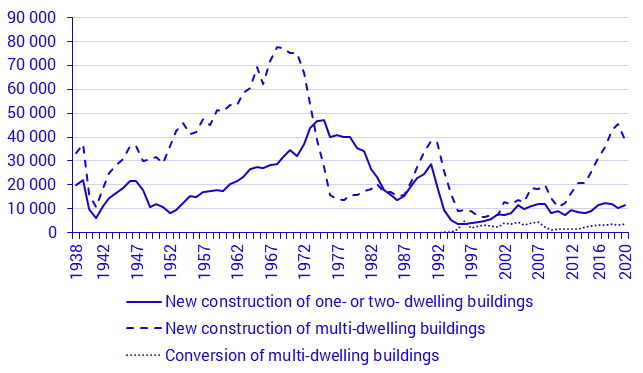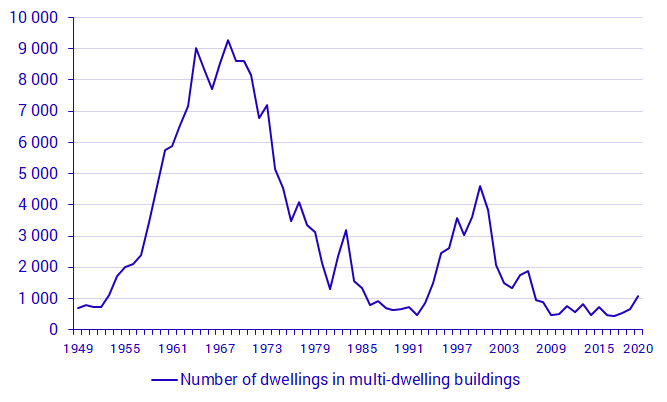Completed new construction, Conversion and demolition of multi-dwelling buildings 2020 – definitive figures
New construction and conversion led to 54 134 new dwellings in 2020
Statistical news from Statistics Sweden 2021-05-10 9.30
In 2020, 38 906 dwellings in total were completed in newly built multi-dwelling buildings. This is 14 percent less than last year.
In one-or two-dwelling buildings, an additional 11 573 dwellings were completed, which is 13 percent more than in 2019. In addition, 3 655 dwellings were completed through conversion of existing multi-dwelling buildings. New construction and conversion led to 54 134 new dwellings in total in 2020, which is 8 percent less than a year ago.

Most new dwellings per inhabitant in Uppsala County
In 14 out of 21 counties in Sweden, fewer dwellings were completed through new construction in 2020 than in the previous year. Fifty-nine percent of the completed dwellings are located in the three metropolitan areas.
Uppsala County accounted for the highest number of completed dwellings per 1 000 inhabitants, at 8.6 completed dwellings per 1 000 inhabitants . This is followed by Södermanland County, at 6.4 completed dwellings per 1 000 inhabitants. In Västernorrland County, there were 0.9 completed dwellings per 1 000 inhabitants, which was the lowest number of completed dwellings in Sweden. The corresponding figure for the country as a whole was 4.9 completed dwellings per 1 000 inhabitants.
| County | Number of dwellings per 1 000 inhabitants |
|---|---|
| Blekinge county | 4.1 |
| Dalarnas county | 2.2 |
| Gotlands county | 1.3 |
| Gävleborgs county | 1.9 |
| Hallands county | 4.3 |
| Jämtlands county | 4 |
| Jönköpings county | 3.7 |
| Kalmar county | 5.7 |
| Kronobergs county | 6.1 |
| Norrbottens county | 3.6 |
| Skåne county | 5.6 |
| Stockholms county | 5.5 |
| Södermanlands county | 6.4 |
| Uppsala county | 8.6 |
| Värmlands county | 3.5 |
| Västerbottens county | 2.3 |
| Västernorrlands county | 0.9 |
| Västmanlands county | 4.7 |
| Västra Götalands county | 5.2 |
| Örebro county | 3.8 |
| Östergötlands county | 4.6 |
| Sweden | 4.9 |
Most new rented dwellings in multi-dwelling buildings
In 2020, most of the completed new dwellings in multi-dwelling buildings were rented dwellings, which is a persistent trend; sixty-one percent were rented dwellings and 39 percent were tenant-owned.
However, the type of tenure varied more by region. In Greater Stockholm, the distribution between rented and tenant-owned dwellings was almost even, compared with 2019, when just over six in ten new dwellings in multi-dwelling buildings were tenant-owned. Outside the metropolitan areas, the proportions were reversed and about seven in ten newly constructed dwellings were rented dwellings.
| Share of Tenant-owned dwellings | Share of Rented dwellings | |
|---|---|---|
| Greater Stockholm | 50 | 50 |
| Greater Göteborg | 49 | 51 |
| Greater Malmö | 37 | 63 |
| Sweden excluding metropolitan areas | 31 | 69 |
| Sweden | 48 | 52 |
Tenant-owned dwellings in one- or two-dwelling buildings continue to become more common. From completion of only a few hundred dwellings yearly over a longer period, there has been an increase in recent years. In 2020, just over 3 000 newly constructed dwellings in one- or two-dwelling buildings were tenant-owned, which is more than one fourth of the one- or two-dwelling buildings that were completed.
More small dwellings being constructed
The most common size of dwelling in multi-dwelling buildings that were completed was a dwelling with two rooms and a kitchen; there were 13 667 dwellings of this size, which is more than one in three dwellings.
Although there were fewer small dwellings completed in 2020 than in the previous year, they still dominate in terms of construction. Among completed dwellings, 23 861 dwellings had two rooms or less, while 15 045 dwellings had three rooms or more.
The average useful floor space for a dwelling is 58 square metres in new construction of multi-dwelling buildings and 143 square metres in one- or two-dwelling buildings.
Housing for students and the elderly
Among the new dwellings in multi-dwelling buildings completed in 2020, 5 608 were classified as special housing. Among these, 1 614 dwellings were designated for students and 2 876 dwellings for elderly or disabled persons.
Conversion of multi-dwelling buildings
In addition to the dwellings completed through new construction in 2020, 3 655 new dwellings were completed through conversion or altered use, which is about 16 percent more than in 2019. About 85 percent of those dwellings were formerly non-residential buildings that were converted into dwellings. Stockholm municipality tops the list at 521 dwellings and 11 percent former attics were converted into dwellings. It is worth noting that attic conversion has increased by nearly 12 percent since 2019.
Demolition of dwellings in multi-dwelling buildings
In 2020, demolition of 1 080 dwellings in multi-dwelling buildings was started. This is just over 300 dwellings more than in 2019, and the highest figure since 2006. The bulk of the demolitions was located outside the metropolitan areas and only 8 percent of dwellings in the metropolitan areas were demolished.

Definitions and explanations
A dwelling is a room or suite of rooms intended for private habitation.
One- or two-dwelling building refers to a detached one- or two-dwelling buildings, as well as semi-detached, row and linked buildings.
Multi-dwelling buildings refers to buildings with three or more apartments, including balcony access housing.
Conversion refers to the net of dwellings added and removed through conversion or changes in usages of multi-dwelling buildings.
Next publishing will be
Preliminary statistics on the first quarter 2021 will be published on 2021-05-25.
Statistical Database
More information is available in the Statistical Database
Feel free to use the facts from this statistical news but remember to state Source: Statistics Sweden.
